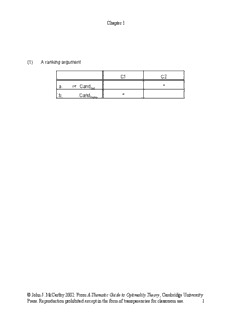
The Fundamentals of Optimality Theory - UMass Amherst PDF
Preview The Fundamentals of Optimality Theory - UMass Amherst
Chapter 1 (1) A ranking argument C1 C2 a. L Cand * Opt b. Cand * Comp © John J. McCarthy 2002. From A Thematic Guide to Optimality Theory, Cambridge University Press. Reproduction prohibited except in the form of transparencies for classroom use. 1 Chapter 1 (2) a. C1 and C2 agree C1 C2 i. L Cand Opt ii. Cand * * Comp b. C1 does not distinguish the candidates (both obey it) C1 C2 i. L Cand Opt ii. Cand * Comp c. C1 does not distinguish the candidates (both violate it) C1 C2 i. L Cand * Opt ii. Cand * * Comp © John J. McCarthy 2002. From A Thematic Guide to Optimality Theory, Cambridge University Press. Reproduction prohibited except in the form of transparencies for classroom use. 2 Chapter 1 (3) Basic OT architecture © John J. McCarthy 2002. From A Thematic Guide to Optimality Theory, Cambridge University Press. Reproduction prohibited except in the form of transparencies for classroom use. 3 Chapter 1 (4) ALIGN(Cat , Cat , Edge) 1 2 The element standing at the Edge of any Cat also stands at the Edge of 1 some Cat (where Cat and Cat are grammatical or prosodic constituents 2 1 2 and Edge is left or right). © John J. McCarthy 2002. From A Thematic Guide to Optimality Theory, Cambridge University Press. Reproduction prohibited except in the form of transparencies for classroom use. 4 Chapter 1 (5) A stringency relation C1 C2 Struc a Struc * b Struc * * c © John J. McCarthy 2002. From A Thematic Guide to Optimality Theory, Cambridge University Press. Reproduction prohibited except in the form of transparencies for classroom use. 5 Chapter 1 (6) A fixed universal hierarchy C1 >> C2 Struc a Struc * b Struc * c © John J. McCarthy 2002. From A Thematic Guide to Optimality Theory, Cambridge University Press. Reproduction prohibited except in the form of transparencies for classroom use. 6 Chapter 1 (7) Harmonic alignment Given a binary dimension D with a scale X > Y and another dimension D 1 2 with a scale a > b > … > z, the harmonic alignment of D and D is the 1 2 following pair of harmony scales: H = X/a ™ X/b ™ … ™ X/z X H = Y/z ™ … ™ Y/b ™ Y/a Y The constraint alignment is the following pair of constraint hierarchies: C = *X/z >> … >> *X/b >> *X/a X C = *Y/a >> *Y/b >> … >> *Y/z Y © John J. McCarthy 2002. From A Thematic Guide to Optimality Theory, Cambridge University Press. Reproduction prohibited except in the form of transparencies for classroom use. 7 Chapter 1 (8) a. Input /pata/ 6 Output pa.ta /pata/ DEP ONSET Remarks i. L pa.ta Faithful ii. a.pa.ta * * Gratuitous epenthesis iii. §a.pa.ta ** Ever more gratuitous epenthesis b. Input /apata/ 6 Output apata /apata/ DEP ONSET Remarks i. L a.pa.ta * Faithful ii. §a.pa.ta * Epenthesis © John J. McCarthy 2002. From A Thematic Guide to Optimality Theory, Cambridge University Press. Reproduction prohibited except in the form of transparencies for classroom use. 8 Chapter 1 (9) Harmonic bounding The mapping /A/ 6 B harmonically bounds the mapping /A/ 6 C if and only if the /A/ 6 B mapping incurs a proper subset of the constraint violations incurred by the /A/ 6 C mapping. © John J. McCarthy 2002. From A Thematic Guide to Optimality Theory, Cambridge University Press. Reproduction prohibited except in the form of transparencies for classroom use. 9 Chapter 1 (10) Different Ranking: Input /apata/ 6 Output §apata /apata/ ONSET DEP Remarks a. L §apata * Epenthesis b. apata * Faithful © John J. McCarthy 2002. From A Thematic Guide to Optimality Theory, Cambridge University Press. Reproduction prohibited except in the form of transparencies for classroom use. 10
Description: